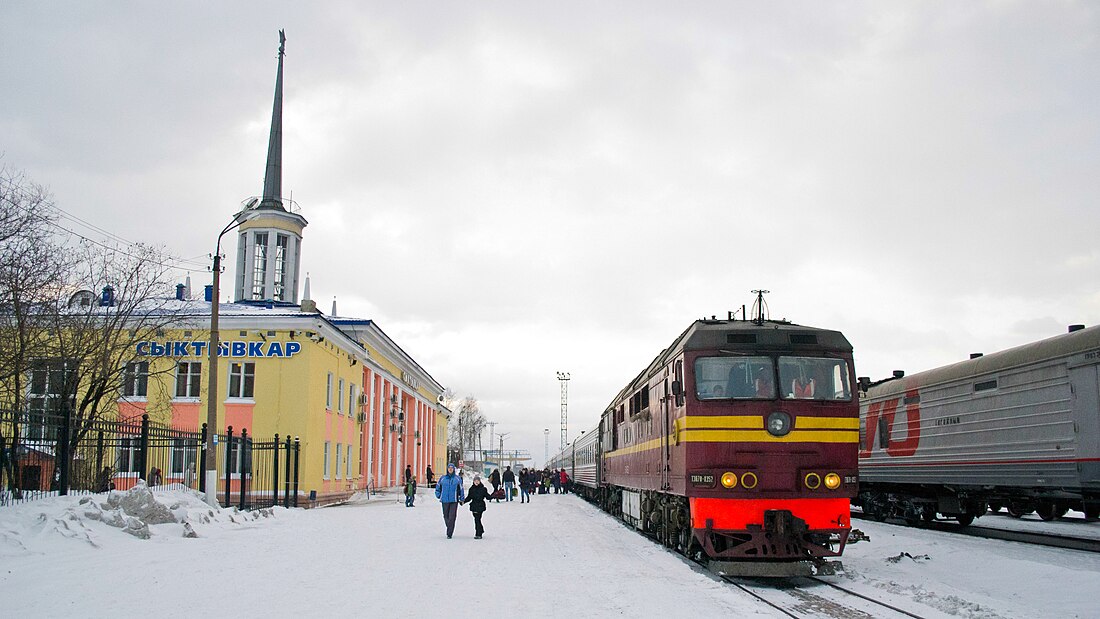Top Qs
Timeline
Chat
Perspective
Syktyvkar
City in the Komi Republic, Russia From Wikipedia, the free encyclopedia
Remove ads
Syktyvkar (/sɪktɪfˈkɑːr/,[8] Russian: Сыктывка́р, IPA: [sɨktɨfˈkar]; Komi: Сыктывкар, IPA: [sɨktɨvˈkar]) is the capital city of the Komi Republic in Russia, as well as its largest city. It is also the administrative center of the Syktyvkar Urban Okrug. Until 1930, it was known as Ust-Sysolsk after the Sysola River.
Remove ads
Etymology
The city's name comes from Syktyv, the Komi name for the Sysola River, and kar, meaning "city" in the Komi language.[9]
Geography
Syktyvkar is located on the Sysola River, which is the origin of its former name Ust-Sysolsk. The city is located close to where the Sysola joins the larger Vychegda River, which is itself a branch of the Northern Dvina.[citation needed]
History
Summarize
Perspective
This section needs additional citations for verification. (August 2022) |

It is believed that the city was founded in 1586 as a settlement Ust-Sysola.[10]
It was granted city status by Catherine the Great in 1780, and in 1992, it became the capital of the Komi Republic.[11] It has remained the capital since then, although a large influx of ethnic Russians in the 20th century has actually left the Komi a minority there.
When Kandinsky stayed there in 1889 to record the culture and beliefs of the locals, the town had a group of administrative buildings along with more numerous log-built peasant huts.[12]
The majority of the population were merchants and peasants. The main occupations of the inhabitants were agriculture, cattle-breeding, hunting, fishing, and trade.
By the beginning of the 20th century, the population had grown to 6,000 people. The Tsarist government made the Komi region a place of political exile.
In 1921, Ust-Sysolsk was given the status of administrative center of the newly formed Komi-Zyryan Autonomous Oblast. It was renamed as Syktyvkar, which is Komi for "a town on the Sysola" in 1930, to mark the 150th anniversary of its receipt of city privileges. In 1936, Syktyvkar became the capital of the Komi ASSR.
Administrative and municipal status
Syktyvkar is the capital of the republic.[1] Within the framework of administrative divisions, it is, together with three urban-type settlements (Krasnozatonsky, Sedkyrkeshch, and Verkhnyaya Maksakovka) and three rural localities, incorporated as the city of republic significance of Syktyvkar—an administrative unit with the status equal to that of the districts.[1] As a municipal division, the city of republic significance of Syktyvkar is incorporated as Syktyvkar Urban Okrug.[5]
Remove ads
Economy
The Sysola, the Vychegda, and the Northern Dvina are navigable and are a major transport route of forestry products from Syktyvkar. Lumber and woodcrafts are the city's largest industries.[citation needed]
Previously Komiinteravia had its head office in Syktyvkar.[13]
Transportation
The city is served by Syktyvkar Airport and Syktyvkar Southwest airfield. The city has a railway station as well. Syktyvkar is the end point of route R176 (Vyatka Highway).
Remove ads
Culture and education
This section needs additional citations for verification. (August 2022) |

Syktyvkar is the center of the cultural life in the republic.
The oldest museum of the Republic of Komi, the National Museum, was founded in 1911. Nowadays, the National Museum is the Literature Memorial Museum of Ivan Kuratov and the museum of Viktor Savin.
The National Gallery was founded in Syktyvkar in 1943. It welcomes exhibitions from different museums of the country. The Theater of Opera and Ballet began its history in 1958.
The National Library numbers 2.5 million volumes, including books in the Russian language, foreign languages and in the Komi language.
Syktyvkar State University was founded in 1972 and has over 3,500 full-time students and 250 faculty members.[14]
The city's folk ensemble "Asya Kya" has been representing Komi Republic on national and international festivals.[15]
One of the oldest Russian progressive rock bands The Gourishankar was founded in Syktyvkar in 2001.
Remove ads
Sports
Stroitel Bandy Club[16] has played many seasons in the Russian Bandy Super League, the highest division of Russian bandy. The team was promoted after the 2016–17 season.[17][18][19] Its home venue is Respublikanskiy Stadion.[20] In the 2016/17 season, the club adopted a new logotype instead of an old one which had a white bear playing bandy.[21]
There is also a youth team called KDYuSSh-1.[22]
Events
- In January 2017 the Bandy Y-19 World Championship was organized in Syktyvkar.[23]
- Syktyvkar was to host the 2021 Bandy World Championship,[24] for which an indoor arena was to be erected.[25] However, the tournament was repeatedly postponed due to the COVID-19 pandemic, and ultimately pulled from Syktyvkar altogether as a consequence of the 2022 Russian invasion of Ukraine.[26]
Remove ads
Climate
Summarize
Perspective
Syktyvkar experiences a subarctic climate (Köppen climate classification Dfc) with long, cold winters and short, warm summers. Compared with areas at a similar latitude in Siberia, winters are less extreme, but still much longer than summer and bitterly cold by European standards.
Remove ads
Notable people
- Victor Oganov, Russian-Armenian boxer
- Feoktista Ivanovna Zaboeva, Russian teacher and folklorist
Twin towns and sister cities
References
External links
Wikiwand - on
Seamless Wikipedia browsing. On steroids.
Remove ads














